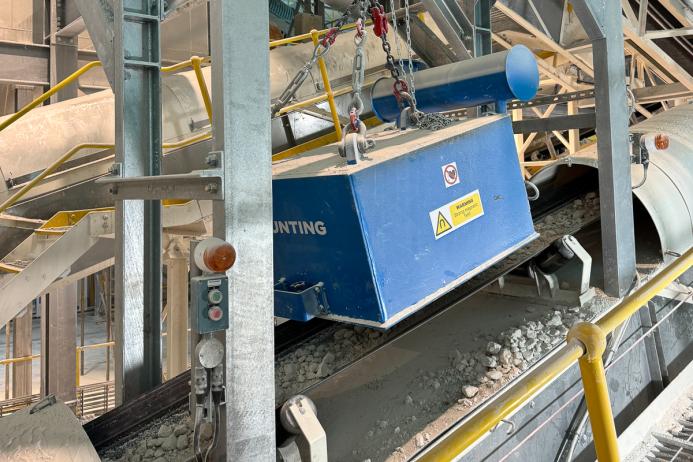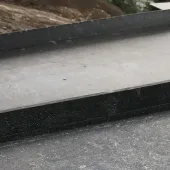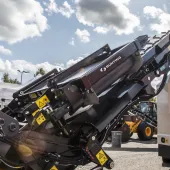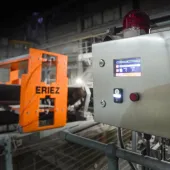Bunting suspension electro magnet solves a problem
New metal-detection installation reduces tripping issue and increases productivity at calcium carbonate quarry
ATHERTON Material Handling have installed a Bunting suspension electro magnet at a calcium carbonate quarry in Melton, UK. The magnet removes tramp ferrous metal prior to a metal detector, reducing the number of metal detection trips and increasing productivity.
Atherton Material Handling originally contacted Bunting – one of the world’s leading designers and manufacturers of magnetic separators, eddy current separators, metal detectors and electrostatic separators – to find a solution to the problem of a metal detector in the quarry tripping too frequently. Tom Higginbottom, Bunting’s technical sales engineer, was invited on site by the Atherton team to review the installation.
Bunting had supplied the original metal detector, a model TN77 series, which was identifying tramp metal that could damage crushers, screens, and conveyors. The metal detector was operating perfectly, but the quantity of tramp metal contamination resulted in frequent tripping, and the need to stop the conveyor for removal of the metal. Even though the metal detector’s performance was providing the ideal protection of processing plant, the frequency of metal-trips was affecting productivity.
Bunting recommended the installation of a suspension magnet prior to the metal detector. This would remove all tramp ferrous metal, which is magnetic, leaving the metal detector to focus on non-ferrous tramp metal such as manganese steel digger teeth.
The troughed conveyor transporting the quarried calcium carbonate was 600mm wide, carrying a densely packed 100mm burden depth of material. This led to the recommendation of a suspension electro magnet that would produce a strong, deep field powerful enough to attract tramp ferrous metal at the bottom of the burden.
The selected suspension electro magnet, model 60 OCW 20, is cooled by oil and weighs just over one tonne. The magnet width is wider than the conveyor, at 925mm, and extends along the conveyor 925mm. This provides plenty of dwell time under the magnet for the attractive force to pull the ferrous tramp metal through the burden.

The suspension electro magnet has three suspension points, which connect to a hand-geared travelling trolley, installed by Atherton Material Handling. This system allows for easy movement of the magnet away from the conveyor for safe and effective removal of all captured tramp ferrous metal off the magnet face.
In operation, the maintenance crew manoeuvres the suspension electro magnet into position over a chute before turning off the magnetic field and allowing all captured metal to discharge from the face of the magnet into a separate collection area.
Suspended 200mm above the conveyor, the magnet generates 650 Gauss on the surface of the belt, which is enough magnetic force to remove a wide range of tramp ferrous metal. The resulting reduction in the number of times the metal detector trips has reduced production downtime without any compromise on protection of the crushers and other processing equipment from tramp metal damage.
‘We worked closely with the Atherton Material Handling team to find a solution for their client,’ explained Tom Higginbottom. ‘The final solution not only maintains and improves important protection against tramp metal damage, but also makes it easy and safe to operate and clean the suspension electro magnet.’










